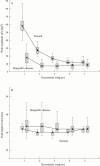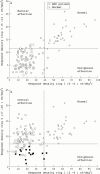Multifocal electroretinography in patients with Stargardt's macular dystrophy
- PMID: 9602623
- PMCID: PMC1722507
- DOI: 10.1136/bjo.82.3.267
Multifocal electroretinography in patients with Stargardt's macular dystrophy
Abstract
Aims: To describe the topography of multifocal electroretinograms (ERGs) and to explore its diagnostic value in patients with Stargardt's macular dystrophy (SMD).
Methods: 51 patients with SMD were examined by means of the m-sequence technique to characterise the topography of electroretinographic responses in the central visual field. The results were compared with data from 30 normal volunteers.
Results: In 49 of 51 patients with SMD, macular electroretinographic activity was markedly diminished or non-detectable. Towards more peripheral areas, ERG responses of the SMD patients approached those of normals. Implicit times were not markedly delayed at any eccentricity.
Conclusion: In contrast with Ganzfeld electroretinography, multifocal electroretinography is useful to detect foveal dysfunction in SMD. Areas of dysfunction were found to be usually larger than expected from psychophysical measurements and morphological alteration. In early stages of the disease it was possible to detect foveal dysfunction, even in patients lacking morphological fundus changes and with good visual acuity.
Figures







References
Publication types
MeSH terms
LinkOut - more resources
Full Text Sources
Medical
